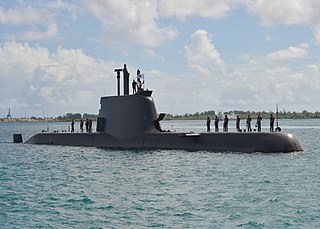
The Type 212A is a class of diesel-electric attack submarine developed by Howaldtswerke-Deutsche Werft AG (HDW) for the German Navy, and the Italian Navy where it is known as the Todaro class. It features diesel propulsion and an additional air-independent propulsion (AIP) system using Siemens proton-exchange membrane (PEM) compressed hydrogen fuel cells. The submarines can operate at high speed on diesel power or switch to the AIP system for silent slow cruising, staying submerged for up to three weeks with little exhaust heat. The system is also said to be vibration-free and virtually undetectable.
Naval Group is a major French industrial group specializing in naval defense design, development and construction. Its headquarters are located in Paris.
Navantia is a Spanish state-owned shipbuilding dedicated to civil and military naval construction, the design of deep-tech systems and the manufacture of structures for the renewable energy sector, such as offshore wind or hydrogen.
Air-independent propulsion (AIP), or air-independent power, is any marine propulsion technology that allows a non-nuclear submarine to operate without access to atmospheric oxygen. AIP can augment or replace the diesel-electric propulsion system of non-nuclear vessels.

The Type 214 is a class of diesel–electric submarines developed exclusively for export by Howaldtswerke-Deutsche Werft GmbH (HDW). It features diesel propulsion with an air-independent propulsion (AIP) system using Siemens polymer electrolyte membrane (PEM) hydrogen fuel cells. The class combines the design principles of the Type 209 submarine family and the features of the Type 212A submarine. However, as an export design, it lacks some of the classified technologies of the Type 212 such as the non-magnetic steel hull that makes it difficult to detect using a magnetic anomaly detector.

The Scorpène-class submarines are a class of diesel-electric attack submarines jointly developed by the French Naval Group and the Spanish company Navantia. It features diesel propulsion and an additional air-independent propulsion (AIP). It is now marketed as the Scorpène 2000.

The Sōryū-class submarines (16SS) are diesel-electric attack submarines. The first boat in the class entered service with the Japan Maritime Self-Defense Force in 2009. The design is an evolution of the Oyashio-class submarine, from which it can most easily be distinguished by its X-shaped stern combination diving planes and rudders. The Sōryūs have the largest displacement of any submarine used by post-war Japan.

The S-80 Plus class is a Spanish class of four submarines being built by the state-owned Spanish company Navantia at its Cartagena shipyard for the Spanish Navy. In common with other contemporary submarines, they feature air-independent propulsion.

The Kalvari-class submarines, formally classified as the Project-75 submarines (P-75), is a class of diesel-electric attack submarines operated by the Indian Navy (IN). Currently being constructed by a syndicate of French and Indian shipyards, namely, Naval Group and Mazagon Dock Limited (MDL) respectively, the class is an export derivative of the French-origin Scorpène-class submarine, originally designed by Naval Group.

KD Tunku Abdul Rahman is a Scorpène-class submarine built for the Royal Malaysian Navy by Naval Group, formerly known as DCNS in Cherbourg, France and Navantia in Cartagena, Spain.
PNS/M Khalid (S-137) is a diesel-electric fast-attack submarine equipped with an air–independent propulsion system and the lead ship of her class active since her commissioning in the Navy in 1999.
The Type 216 is a submarine design concept announced by the German shipbuilding company Howaldtswerke-Deutsche Werft based on the Type 212/214.

Project-75 (India), simply referred to as the P-75(I) program, is a military acquisition initiative affiliated to India's Ministry of Defence (MoD), aimed at the planned procurement of diesel-electric submarines for the Indian Navy (IN). Originally conceived in 1997, the initiative's objective has been to procure a class of six conventionally-powered attack submarines for the Indian Navy Submarine Arm, as a replacement for the force's Sindhughosh-class submarines.

INS Khanderi (S22) is the second of the Indian Navy's six Kalvari-class submarines being built in India. It is a diesel-electric attack submarine which was designed by French naval defence and energy company DCNS and manufactured at Mazagon Dock Limited in Mumbai.

The Itaguaí Construções Navais S.A. known as ICN, is a Brazilian state-owned defence company specialized in naval-based platforms and naval nuclear engineering, founded on 21 August 2009. The company employs nearly 2,000 people.

Carrera (SS-22) is a Scorpène-class submarine built for the Chilean Navy by DCNS in Cherbourg and Navantia in Cartagena, Spain.

O'Higgins (SS-23) is a Scorpène-class submarine built for the Chilean Navy by DCNS in Cherbourg and Navantia in Cartagena, Spain.
The Hangor-class submarines are a class of diesel–electric attack submarines currently being manufactured by a joint-partnership of the China Shipbuilding Industry Corporation (CSIC) and the Karachi Shipyard & Engineering Works (KSEW) for the Pakistan Navy (PN). Eponymously christened after the former-Daphné-class submarines that the PN operated between 1970 and 2006, the class is an export derivative of the Chinese-origin Type 039A/041 attack submarine, currently operated by the People's Liberation Army Navy (PLAN). First unveiled to the public in 2018, the future submarines are envisaged to undertake anti-access/area denial operations within Pakistan's exclusive economic zone, through the use of heavyweight torpedoes and anti-ship cruising missiles.

INS Vagsheer (S26) is the sixth submarine of the first batch of six Kalvari-class submarines for the Indian Navy. It is a diesel-electric attack submarine based on the Scorpène class, designed by French naval defence and energy group Naval Group and manufactured by Mazagon Dock Limited, an Indian shipyard in Mumbai, Maharashtra.

The Riachuelo class are a Brazilian class of diesel-electric and nuclear-powered attack submarines developed by the state-owned shipyard Itaguaí Construções Navais, based on the French Scorpène class as part of the Submarine Development Program.












